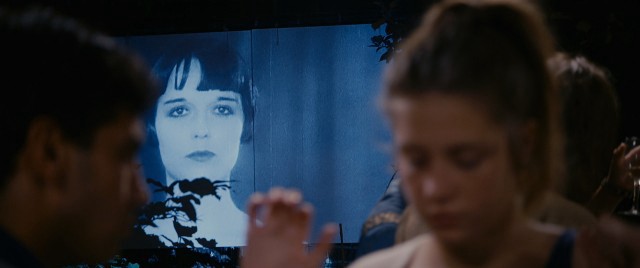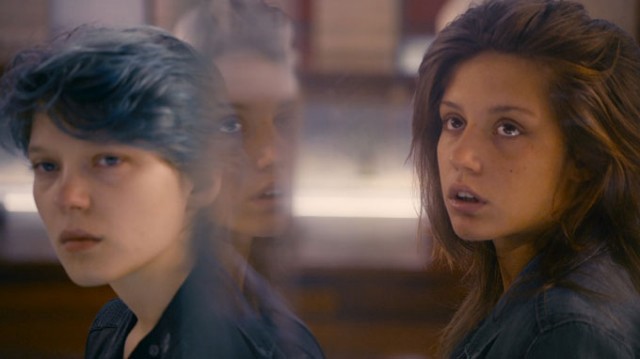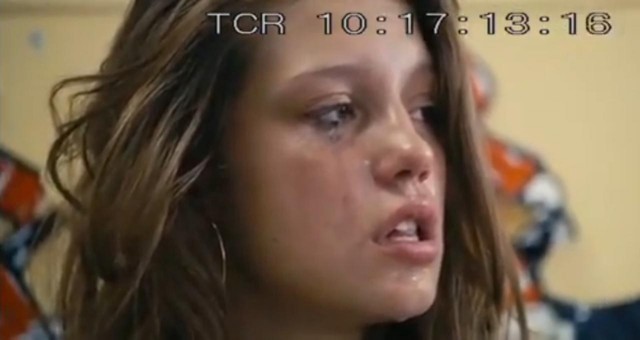Acting For, Anticipating, Speaking Back to the Male Gaze: In Praise of Adèle Exarchopolous

At the 2013 Cannes Film Festival, the coveted Palme d’Or was awarded to Blue Is The Warmest Color, a three-hour coming-of-age lesbian film. This three-hour French lesbian film beat out other contenders such as A Touch of Sin (by a CHINESE PERSON) and Inside Llewyn Davis! (Note: the most recent Coen Bros film is truly a touching meditation on masculinity, but!) In presenting the prize, this year’s jury (headed by Steven Spielberg) made an exception: rather than simply give the Palme d’Or to director Abdellatif Kechiche, the award was to be shared among Kechiche and the film’s two leads, Adèle Exarchopoulos and Léa Seydoux.
Cannes’s acknowledgement of Exarchopolous’s and Seydoux’s massive contributions to BITWC was on point; it also preceded the backlash that now accuses Kechiche’s film of being governed by the (in this case, particularly) damning male gaze. Oof. And here I thought we were making progress.
Lorrie Moore in the NYRB is probably the most recent version of the frequently contradictory and repetitive discourse this particular line of criticism has generated. The earliest example comes from Manohla Dargis, who condemned the film both during and after Cannes. Julie Maroh, whose graphic novel BITWC is partly based on, wrote that Kechiche downplayed the lesbian aspects of her story.
The criticism boils down to this: Kechiche is a leering, exploitative, and selfish male director whose lesbian film suggests the violence of patriarchy both in and of his work. Special attention is given — by Kechiche and reviewers alike — to certain sex scenes. While Cannes acknowledged BITWC as a collaborative affair (as almost all films are) that rested on a singular synergy between Exarchopolous and Seydoux, these reviews reasserted creative power and initiative entirely back to the director.
So, I’m a little torn. You’d think I’d automatically side with Dargis and Moore over some straight male movie director I know almost nothing about, but the thing is: I saw the film. And from these reviews, it doesn’t feel like I’m reading about the same film.
I don’t know if there is finally any clear thesis about the sexual politics of BITWC, or that one should attempt to write it. And while I’m not trying to order Dargis, Moore, Exarchopolos, and Seydoux into some hierarchy of Problematic Feminists, this is also definitely not an essay that tries to laud Kechiche. My aim is instead to draw attention elsewhere, because what Feminism in 2013 often seemed to ask us to spend time arguing over were red herrings.
The problem of Blue Is The Warmest Color, and the problem in critiquing it, has produced at once attenuated and oversimplified reviews because of how difficult it is to come down with a definitive statement about the aesthetic (read: political) aspects of Kechiche’s film. It’s easy to say that the male gaze dictates the film; it dictates most of this world. What this criticism also does, though, is a great disservice to the bodies doing the bulk of the actual, visual, performative work we see when we watch the film.
Reviews that chalk BITWC up to the male gaze, or, even worse, up to its seven-minute-long sex scene, not only erase the work in and of the film, but the work of Exarchopolos and Seydoux. Dargis and Moore analyses’ try to force a reading of the sex scene by way of reducing Exarchopolos and Seydoux just as Kechiche, they write, has already done. In both the patriarchal and feminist readings, the actors are objectified bodies on display.

The two leads are beautiful, yes, and they’re especially beautiful together. But beauty, while not radical, does not obviate an awareness of what that beauty means on a movie screen. The film’s relentless three-hour focus, through her body, on Exarchopolos’s devastatingly nuanced performance was a comment on the stakes of such exposure. Exarchopolos almost always looks uncomfortable in her environment. She’s often literally found in tears.
Kechiche’s sex scenes are described as lurid, pornographic, violent, and exploitative. What is implied, though not often said outright, in reviews, is exactly how unsexy the sex scenes are. From a formal perspective, what comes across most to me is just how tired everyone looks. The lighting is so unflattering. The shots are clinical, as Maroh suggests in her review, but what if they’re sterilized in a way to emphasize the danger of such displays. The scene is violent (in more ways than one!), but I don’t know if its primary goal is to serve and satisfy the male gaze. It may be governed, as most sex scenes are, by that notorious gaze, but I don’t know if it’s meant to placate so much as to condemn it. Was the lighting trying to make it seem more real? Or just incredibly uncanny? What I like about uncanniness is that it suggests doubling, or more than one way of seeing the world. Rather than assume viewers merely took pleasure in these scenes, might it be possible that viewers were also complicit in the metaphors of violence used to describe the film?
This is how Dargis begins her Times review:
It was her derrière that first caught my eye. Specifically, it was the way the camera captured the pretty teenager’s rear end in “Blue Is the Warmest Color” so that it was centered and foregrounded in the frame.
I don’t know if Kechiche’s opening shots of Exarchopolos’s ass (which, include, y’know, her whole body, as well as her neighborhood, and surrounding moving traffic) are just that, or even mainly that. What first caught my eye was how she’d continually pull her pants up, as though conscious of her, ahem, derrière — afraid that it would be viewed the wrong way. There are more ways of suggesting anality. Just watch Rope, which is by a director that Dargis mentions in her review as another notoriously sexist, though Hitchcock’s gay film is of course about male assholes.
Wow! Before this starts sounding like an essay defending lecherous male directors, I want to turn the lens back on Exarchopolos and Seydoux. But not in an objectifying way!! What was most fiercely communicated in BITWC was just how much energy and love one could show vis-à-vis narrative film. Visual storytelling isn’t just about pinning women’s bodies on screen, but allowing them to evolve. My favorite scenes in the film involved Adèle’s body in ways tangential to sex — when she was eating, when she was dancing, when her eyes flickered nervously to the side of her face.

I’ve lost count of how many times I’ve heard someone say Blue Is The Warmest Color would have been a much better film without that sex scene. Indeed, how many critics have judged Kechiche’s film solely on that scene? But if this is how you determine whether a film works or not, maybe you’re not really watching, you know, the whole film?
Criticisms of BITWC lean pretty hard on telegraphing the MALE GAZE by, well, invoking the male gaze. But Laura Mulvey’s essay is forty years old and, really, we have no excuse not to take what was original a seminar paper into newer, expansive territory. Sometimes I feel like “Visual Pleasure and Narrative Cinema” largely still gets invoked just to call out MALE GAZE without saying much about how, where, or in what forms it presents itself. The sex scenes in BITWC are actually doing the opposite of what Mulvey describes as serving the male gaze — they are disjointed and not fluid — they’re anarrative. They ask us to question their incoherence.
In her review, Dargis states that she wished to avoid “male gaze” rhetoric in her criticism. Instead, Dargis points to John Berger’s axiom, “Men look at women. Women watch themselves being looked at.” Berger’s concept here is also how we’ve come to understand the processes of sympathy and identification — which are often still events of misrecognition, bringing us back to Mulvey’s essay. What is notable about the gaze in BITWC is how emphatic the film remains about the possibility that women are watching other women think through female self-presentation. What does Exarchopolos and Seydoux’s interactions do to how we think about narcissistic and scopophilic pleasure? Hmmmmm. I’m not sure, but I want to read that essay if someone would write it!
Aesthetics cannot be disassociated from meaning in narrative storytelling. Aesthetics can definitely not be disassociated from meaning in visual narrative storytelling, such as found in film. (Mulvey’s essay was talking about classic Hollywood cinema. How exactly does the male gaze function in a three-hour coming-of-age French lesbian film? IDK! No one asks!) As Dargis writes: “The man’s words and the women’s silence are aesthetic choices, and as much a part of the movie’s meaning as the hand-held cinematography.” I agree — aesthetical and technological choices affect the political content of a film alike — but I don’t think reviews of BITWC have followed through on the analytical rigor suggested by Dargis’s statement.
Silence can mean more than one thing, and it follows that silence might also be interpreted in more than one way. Adèle’s silences are particularly telling: they’re a performance of a performance of female submissiveness and hesitation. Kechiche might be an asshole (he sounds like one!), but that doesn’t null the potential meanings of Exarchopolos’s performance. What if her silences were a critique on the eighteenth-century novel tradition (the film also borrows from Pierre de Marivaux’s unfinished novel La Vie de Marianne) that makes women the object of being aggressively looked at, but never heard?
On this subject Marivaux wrote his novel. Kechiche’s film can address the male gaze into other territory. (It’s interesting that Mulvey’s male gaze of classic narrative cinema has inversely seeped into literary criticism. One cannot un-see that male gaze!) Marivaux’s Marianne, aware that she’s constantly being looked at, works to control the effects of her appearance. In their performances, is it possible that Adèle and Exarchopolos know they’re acting for a particular gaze, are anticipating those eyes, and even speaking back to them? Looking is not always a one-way street. Maybe it’s my prurient mind getting ahead of itself, but I’m actually just curious.
What I actually really loved about Dargis’s review: how mad she sounded. Anger is still an emotion and reaction women steer clear of if they hope to be taken seriously. Let’s get more publicly angry in 2014! Let’s start talking about anger and conflict next year as much as we discussed sex in this one.
Jane Hu is a writer living in Montreal.